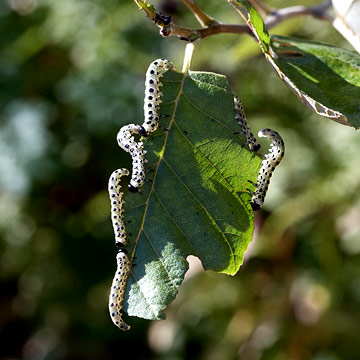






Sawflies are one of the few insects in the wasp family that feed on plants. The adult resembles a fly or a wasp without a constricted waist. But it's the worm-like larva that causes damage to plants. The adults do not eat and cannot sting.
continue reading belowSome larvae look like caterpillars with three pairs of large legs and seven pairs of smaller false legs. The larvae may appear individually, but often form clusters of dozens of chewing defoliators. It's common to see them lined up along the edge of leaves or needles. When disturbed, they may raise their abdomen and tail end into an s-shape defensive position.
Other sawfly larvae resemble slugs, with a slimy non-segmented body. This group of sawfly larvae usually feeds only on the leaf surface, leaving a skeleton of leaf veins where they feed.
Adult sawflies lay eggs in or on leaves. The larvae hatch out in late spring or early summer and begin feeding. They spin cocoons when fully grown. Some species have only one generation per year; others may have several generations.
The best time to control sawflies is early in their larval stage. The natural insecticide spinosad will control sawfly larvae. Conventional insecticides such as malathion are also effective. Bt (Bacillus thuringiensis), which is an effective natural control for true caterpillars, is ineffective on sawfly larvae.
Most sawflies attack only one species or closely related species of plants, and the common name of the sawfly usually includes its host. Examples are:
Ash Sawfly (Blackheaded and Brownheaded)
Dogwood Sawfly
Dusky Birch Sawfly
Elm Sawfly
Larch Sawfly
Loblolly Pine Sawfly
Mountain Ash Sawfly
Oak Sawfly
Pear Sawfly (also known as Pear Slug)
Pine Sawfly (European, Introduced, Redheaded, and Virginia)
Raspberry Sawfly
Roseslug Sawfly
White Pine Sawfly
Willow Sawfly
Yellowheaded Spruce Sawfly
Copyright © www.100flowers.win Botanic Garden All Rights Reserved